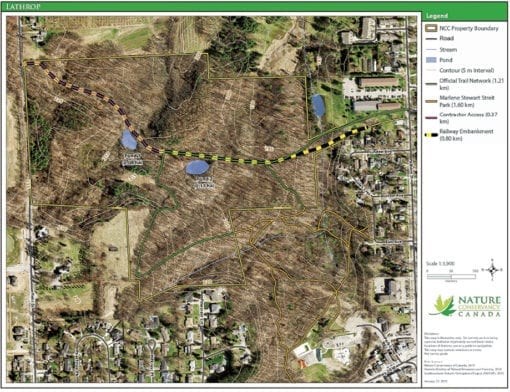Trail safety, danger to downstream properties, and damage to Twelve Mile Creek prompt proposal
A hidden natural gem right in the heart of Fonthill, the Lathrop Property is a 24-hectare reserve that adjoins Marlene Stewart Streit Park. It has been owned by the Nature Conservancy of Canada since 1998, when it was donated to the Conservancy by the Lathrop family, and is held by that organization as a natural environment, protected from development.
The Nature Conservancy has announced plans to make improvements to the property to protect the headwaters of Twelve Mile Creek and stabilize the trail system that bisects the reserve.
An old rail line extended from Hurricane Road across North Pelham Street, through the property all the way to Haist Street. Two small quarries were dug adjacent to the rail line to supply fill for the rail bed to be built up into a berm or embankment across the deep gullies created by the creek to accommodate the trains. That berm now forms one of the main trails used by the public who visit the reserve, and the two quarries are now ponds whose overflow seeps through the berm into small streams that eventually become Twelve Mile Creek. The seepage is contributing to the deterioration of the berm and creates a potential danger for trail walkers and downstream properties should the berm fail.

The Nature Conservancy recognized this danger and began investigations into remedies. Early in the process they contacted the Niagara Chapter of Trout Unlimited Canada (TUC), whose interest in restoring and preserving Twelve Mile Creek is long established. The Niagara Chapter became enthusiastic participants in the process, as the ponds are contributors to the warming of the headwaters. Temperature monitoring reveals that the spring water that enters the ponds is about 12 degrees and the water on the downstream side of the berm, having been warmed by the ponds, is between 17 and 20 degrees. Twelve Mile Creek is the last remaining cold-water system in Niagara capable of sustaining populations of native Brook Trout and other cold-water-reliant species which are threatened by the rising temperatures. The five-to-eight degree warming of the stream is literally life or death for these species.
Studies have been completed by Niagara College’s Ecosystem Restoration students and Geographic Information Systems students, as well as by Savanta, the environmental consulting company hired by the Conservancy to determine the present state of the berm and the ponds and to suggest ways in which the dangers they represent can be reduced. These studies are ongoing, and may result in some minor disruption on the trail as some vegetation must be cleared.
However, Liv Monck-Whipp, the Conservancy co-ordinator for Southwestern Ontario, is quick to point out that “species at risk locations have been mapped and will be protected from the ongoing work.”
Monck-Whipp says that the proposals that are emerging “may involve the removal or reduction of some sections of the berm, stabilization, culvert installation, and/or the addition of a small bridge or boardwalk across wet sections.”
The reduction or elimination of at least one of the ponds is also a likely possibility.
“By reducing the amount of warm water and sediment leaving the ponds, it is anticipated that Brook Trout and other fish species will benefit from cleaner, cooler water and improved water flow,” she says.
One public meeting was held in August at the community centre to inform the public of the proposed work and to get opinions about the various options. According to Monck-Whipp, other meetings are planned as the process unfolds and will be advertised with signage at the property and through media releases.
Initial estimated cost of the three-year project is $285,000, and while the Conservancy has raised enough money for the initial survey and mapping, Liv Monck-Whipp says, “We must raise $150,000 to ensure the best outcomes for the species and habitats we are aiming to protect, as well as trail safety.” Donations to the project will be matched by the National Fish and Wildlife Foundation.
The Lathrop property can be reached from North Pelham Street via a corridor opposite Hurricane Road, between the Spring Valley Manor apartment building to the north and residences to the south. The property extends all the way west to Haist Street, but at present there is no trail access from Haist. That may eventually change when any construction takes place, as equipment will have to use Haist Road to access the site.
Anyone interested in contributing to the project may email the Conservancy at [email protected]


